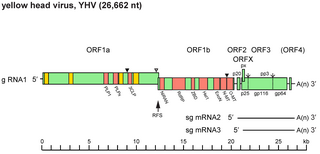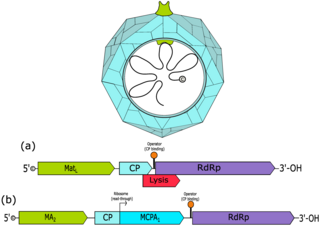This article relies largely or entirely on a single source .(May 2021) |
| Lefavirales | |
|---|---|
| Virus classification | |
| (unranked): | Virus |
| Class: | Naldaviricetes |
| Order: | Lefavirales |
| Subtaxa | |
This article relies largely or entirely on a single source .(May 2021) |
| Lefavirales | |
|---|---|
| Virus classification | |
| (unranked): | Virus |
| Class: | Naldaviricetes |
| Order: | Lefavirales |
| Subtaxa | |
Lefavirales contains the following three families: [1]
Virus classification is the process of naming viruses and placing them into a taxonomic system similar to the classification systems used for cellular organisms.

Okavirus is a genus of enveloped positive-strand RNA viruses which infect crustaceans. Host organisms are mostly shrimp. It is the only genus in the family Roniviridae. Viruses associated with the genus include: gill-associated virus (GAV) which causes reddening, biofouling with exoparasites, emaciation, and massive mortality; and yellow head virus (YHV) which causes yellow head, arrest of feeding, and massive mortality. The name is derived from the 'Oka' or lymphoid organ in which the viruses are commonly detected and in which pathology occurs during acute infections. Lymphoid organs are anatomical structures common to penaeid shrimp. There are three species in this genus.

Closteroviridae is a family of viruses. Plants serve as natural hosts. There are four genera and 59 species in this family, seven of which are unassigned to a genus. Diseases associated with this family include: yellowing and necrosis, particularly affecting the phloem.

Fiersviridae is a family of positive-strand RNA viruses which infect prokaryotes. Bacteria serve as the natural host. They are small viruses with linear, positive-sense, single-stranded RNA genomes that encode four proteins. All phages of this family require bacterial pili to attach to and infect cells. The family has 185 genera, most discovered by metagenomics. In 2020, the family was renamed from Leviviridae to its current name.
Luteoviridae was a family of viruses. The family was abolished in 2020 based on evidence that its three genera and seven species unassigned to a genus belonged to two other, existing families.

Arteriviridae is a family of enveloped, positive-strand RNA viruses in the order Nidovirales which infect vertebrates. Host organisms include equids, pigs, Possums, nonhuman primates, and rodents. The family includes, for example, equine arteritis virus in horses which causes mild-to-severe respiratory disease and reproductive failure, porcine reproductive and respiratory syndrome virus type 1 and type 2 in pigs which causes a similar disease, simian hemorrhagic fever virus which causes a highly lethal fever, lactate dehydrogenase–elevating virus which affects mice, and wobbly possum disease virus.

Chrysoviridae is a family of double-stranded RNA viruses. Members of the family are called chrysoviruses.

The International Committee on Taxonomy of Viruses (ICTV) authorizes and organizes the taxonomic classification of and the nomenclature for viruses. The ICTV develops a universal taxonomic scheme for viruses, and thus has the means to appropriately describe, name, and classify every virus taxon. The members of the International Committee on Taxonomy of Viruses are considered expert virologists. The ICTV was formed from and is governed by the Virology Division of the International Union of Microbiological Societies. Detailed work, such as identifying new taxa and delimiting the boundaries of species, genera, families, etc. typically is performed by study groups of experts in the families.
Rudiviridae is a family of viruses with linear double stranded DNA genomes that infect archaea. The viruses of this family are highly thermostable and can act as a template for site-selective and spatially controlled chemical modification. Furthermore, the two strands of the DNA are covalently linked at both ends of the genomes, which have long inverted terminal repeats. These inverted repeats are an adaptation to stabilize the genome in these extreme environments.

Alphaflexiviridae is a family of viruses in the order Tymovirales. Plants and fungi serve as natural hosts. There are 65 species in this family, assigned to six genera. Diseases associated with this family include: mosaic and ringspot symptoms.
Gammaflexiviridae is a family of viruses in the order Tymovirales. Fungi serve as natural hosts. There is only one genus in the family, Mycoflexivirus, which has one species: Botrytis virus F.

Bottigliavirus is the only genus in the family Ampullaviridae and contains 3 species. Ampullaviridae infect archaea of the genus Acidianus. The name of the family and genus is derived from the Latin word for bottle, ampulla, due to the virions having the shape of a bottle. The family was first described during an investigation of the microbial flora of hot springs in Italy.
Hukuchivirus is a genus of double-stranded DNA viruses that infect thermophilic bacteria. The genus was previously named Gammasphaerolipovirus.
Permutotetraviridae is a family of viruses. Lepidopteran insects serve as natural hosts. The family contains one genus that has two species. Diseases associated with this family include: infection outcome varies from unapparent to lethal.
Tubulavirales is an order of viruses.
Arfiviricetes is a class of viruses.
Preplasmiviricota is a phylum of viruses.
Durnavirales is an order of double-stranded RNA viruses which infect eukaryotes. The name of the group derives from Italian duplo which means double, rna for the type of virus, and -virales which is the suffix for a virus order.

Adnaviria is a realm of viruses that includes archaeal viruses that have a filamentous virion and a linear, double-stranded DNA genome. The genome exists in A-form (A-DNA) and encodes a dimeric major capsid protein (MCP) that contains the SIRV2 fold, a type of alpha-helix bundle containing four helices. The virion consists of the genome encased in capsid proteins to form a helical nucleoprotein complex. For some viruses, this helix is surrounded by a lipid membrane called an envelope. Some contain an additional protein layer between the nucleoprotein helix and the envelope. Complete virions are long and thin and may be flexible or a stiff like a rod.
Naldaviricetes is a class of viruses, which infect arthropods. Members of Naldaviricetes are characterized by large enveloped rod-shaped virions, circular double-stranded DNA genomes, and replication in the nucleus of the host cell. All of them share a set of unique genes not found in other viruses, which include the presence of multiple interspersed direct repeats, various subunits of DNA polymerase and RNA polymerase, four late expression factor genes, and infectivity factor genes suggesting a common host entry mechanism.